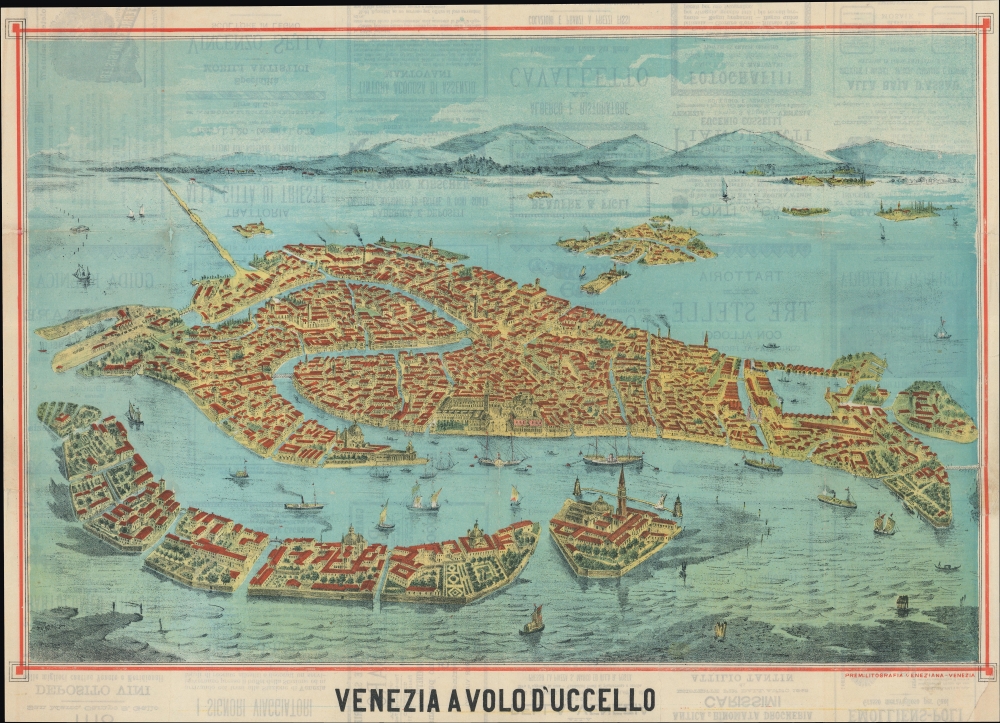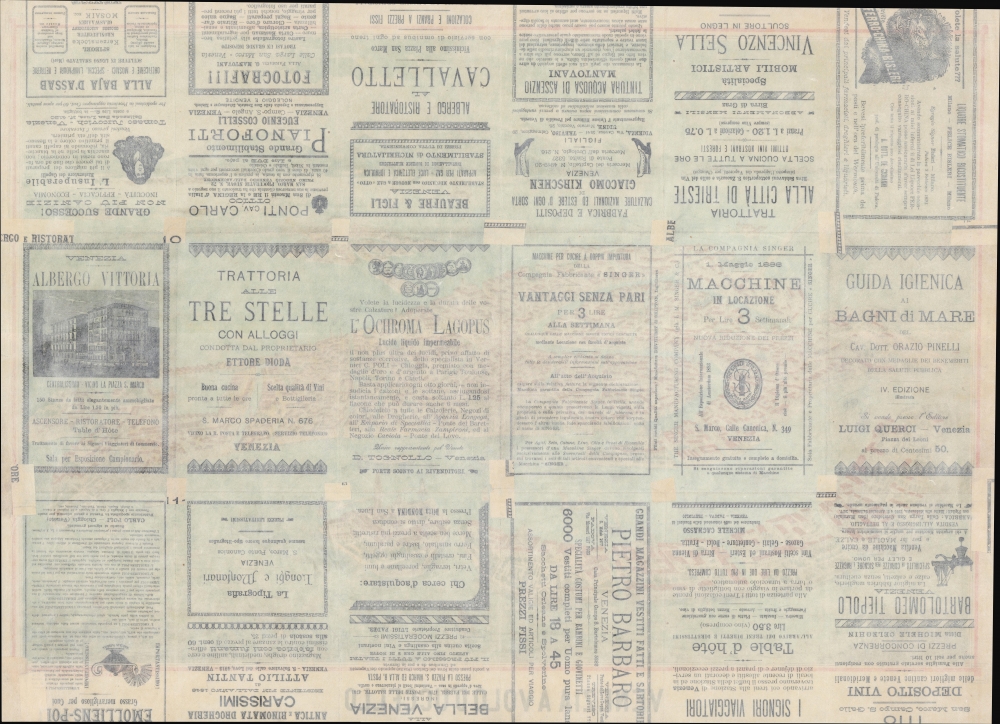This item has been sold, but you can get on the Waitlist to be notified if another example becomes available, or purchase a digital scan.
1888 Litografia Veneziana Bird's Eye View of Venice, Italy
VeneziaView-litografiaveneziana-1888$500.00

Title
Venezia a volo d'uccello.
1888 (undated) 19.5 x 27.5 in (49.53 x 69.85 cm)
1888 (undated) 19.5 x 27.5 in (49.53 x 69.85 cm)
Description
A c. 1888 chromolithographed bird's-eye view of Venice, Italy, printed by Litografia Veneziana. It was produced in the years after Venice was 'returned' to Italy following the 1866 Third Italian War of Independence.
The causeway in the background at left was opened in 1846 as the Gran Ponte della Laguna Veneta, operating a rail service connecting with Milan. The rail line remains in use today, and an automobile roadway was added in 1933. In Venice, passenger service terminates at the Stazione di Venezia Santa Lucia (opened 1861), while freight trains continue to the city's modern port, just south.
A Closer Look
Oriented towards the northwest, the view covers the main islands and districts (sestieri) of Venice, along with surrounding islands in the Laguna Veneta. St. Mark's Square (Piazza San Marco) sits near center towards bottom. The islands of Giudecca (subdivided by canals) and San Giorgio Maggiore occupy the foreground, while additional islands are displayed in the background, including the Isola di San Michele, containing the city's main cemetery, which houses the tomb of Igor Stravinsky, among others. Boats of various types ply the waters, including paddle steamers and other steamships. Advertisements on the verso range from local businesses to Singer sewing machines.The causeway in the background at left was opened in 1846 as the Gran Ponte della Laguna Veneta, operating a rail service connecting with Milan. The rail line remains in use today, and an automobile roadway was added in 1933. In Venice, passenger service terminates at the Stazione di Venezia Santa Lucia (opened 1861), while freight trains continue to the city's modern port, just south.
Historical Context
This view was published some 20 years after Vencie joined Italy. Following the tumultuous changes of the Napoleonic Wars (1803 - 1815), the city became part of the Austrian-aligned Kingdom of Lombardy-Venetia. However, Italian nationalist sentiment pressed continually for independence and union with the rest of Italy as part of a wider Risorgimento. The rail causeway mentioned above was an important tangible link in this process, while an uprising in 1848 briefly re-established the independent Venetian Republic. Finally, in 1866, the Kingdom of Lombardy-Venetia became defunct, and Venice, along with the rest of the Veneto, joined the Kingdom of Italy following the Third Italian War of Independence (which was, in effect, a theater of the Austro-Prussian War). Although the port had become diminished in the preceding centuries, falling behind nearby Trieste in particular, its incorporation into unified Italy was symbolically important and widely celebrated.Chromolithography
Chromolithography, sometimes called oleography, is a color lithographic technique developed in the mid-19th century. The process involved using multiple lithographic stones, one for each color, to yield a rich composite effect. The process would often start with a black basecoat upon which subsequent colors were layered. Some chromolithographs used 30 or more separate lithographic stones to achieve the desired effect. Chromolithograph color could also be blended for even more dramatic results. The process became extremely popular in the late 19th and early 20th centuries, when it emerged as the dominant method of color printing. The vivid color chromolithography produced made it exceptionally effective for advertising and propaganda.Publication History and Census
This view was printed by Litografia Veneziana c. 1888. The only item in the OCLC matching its description is an 1891 view printed by the same and published by Luigi Querci, whose name appears in an advertisement on the verso here, held by the Boston Athenaeum. However, the verso content appears to differ, signifying an alternate printing, with the Singer advertisements on the verso here suggesting a date of 1888. This view is scarce to the market regardless of printing.Cartographer
Litografia Veneziana (fl. c. 1835 - 1901) was a lithographic publisher based in Venice, Italy. Little is known about the firm and its output, but cataloged works primarily consist of maps, photographs, and books focusing on Venice and the surrounding Veneto region. A firm named Tipo-litografia Veneziana, which operated into the late 1910s, emerged around the same time that Litografia Veneziana became inactive and may be a successor or simply the same firm with a new name. More by this mapmaker...
Condition
Good. Stabilized on archival tissue. Several small tears professionally repaired. Text on verso somewhat visible on recto. Bottom right corner repaired. Some trimming, evident only on verso.
References
OCLC 637091683 (potential alternate printing).




